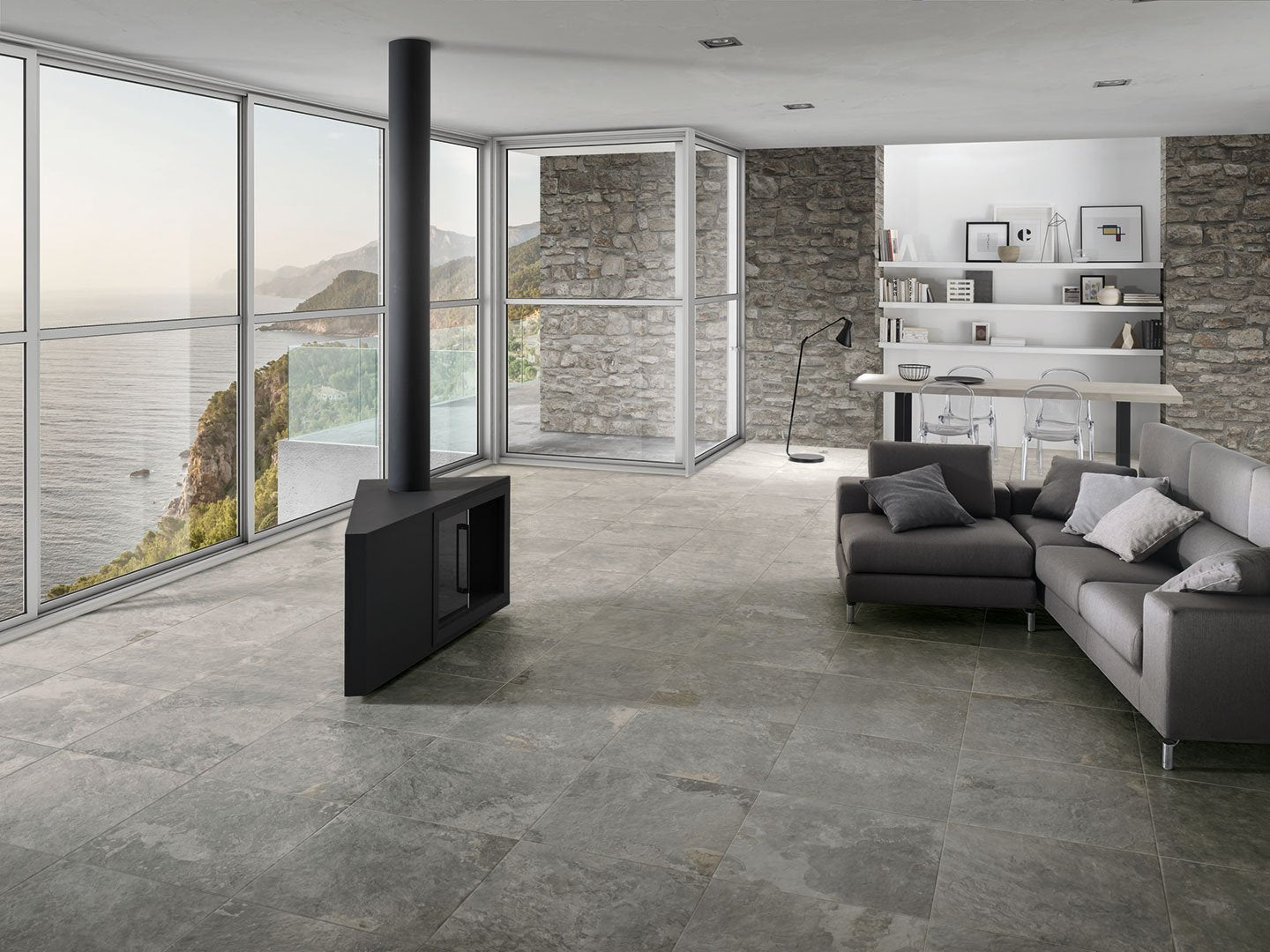When it comes to tile, there are two kinds that are quite similar—natural stone and ceramic. They're both hard surface materials with comparable characteristics and durability. They're both also made from natural materials, installed the same and require the same level of care. Natural stone and ceramic tile each have their own benefits and drawbacks, depending on where they're installed. But, which one should you choose? Well, let's learn about each one to help you make the right decision!
What is Natural Stone and Ceramic Tile?
Natural stone tile is exactly how the name sounds. It's a non-man-made, all-natural material straight from Mother Earth! There's a variety of different natural stones, like slate, granite, marble, limestone, travertine and sandstone. To learn more about each one, check out our other blog, here.

Ceramic is a tile that's typically made from red or white clay that has been fired in a kiln. Ceramic tile is available in two forms—glazed and unglazed. The vast majority of ceramic tile is manufactured with glaze to create an impervious seal over the natural clay material surface. The glazed surface is tough, waterproof and highly stain-resistant. Also, doesn't need any sealer or protective finish of any kind.
Unglazed tile is really ceramic in its natural state. It's very porous and will easily absorb liquids and stains. To avoid any of those risks, it's highly recommended to properly seal the tile right after it's installed with a quality chemical ceramic tile sealer.
Natural Stone vs. Ceramic Tile Pros and Cons
Durability
Ceramic tile comes in a variety of hardness ratings. For ultimate durability, look for tile with a higher PEI rating, ideally a PEI of 3 or above. Lower PEI ratings are better for backsplashes and applications that won't endure foot traffic.
As a general note, natural stone is more durable than ceramic when cared for properly and the wear and tear adds to the characteristics that give stone its appeal and charm.
Cleaning & Maintenance
Basic maintenance is necessary to keep both natural stone and ceramic tile looking like new. Both require regular cleaning but the way to do it varies between the two.
Natural stone materials are porous and require a sealant or glaze to help fill the pores and make the material resistant to water and stains. The sealant will need to be reapplied periodically, depending on what type of natural stone material you go with. When it comes to everyday maintenance, stay away from acidic cleaners, as it could damage the stone itself.
Ceramic tile that's glazed is ready to use without an additional coating. If you're worried about staining, you may want to add a sealant over the grout to keep it as clean as the surrounding tile. Unglazed ceramic tile will need a sealant or top coat to protect it from staining, much like natural stone. The durable glaze on ceramic tile makes it suitable for use with a wide variety of cleaning products.
Color Variations

The style of your home will help dictate either natural stone or ceramic tile flooring, and which material will best achieve that look for the space. Natural stone comes in a wide variety of natural color variations, ranging from crisp whites to deep beige and brown tones. The material chosen will help to dictate the color of the flooring.
Because ceramic tile is man-made, it can come in countless color and pattern variations. It can even be made to resemble the look of natural stone or hardwood planks. The versatile color selections of ceramic tile make it easy to find a ceramic tile that coordinates with an interior décor.
Cost
Because natural stone is, well, natural, it's one of the more expensive tile options. Their luxurious look makes the expense worth it if the budget allows for it.
Ceramic tile is one of the most affordable options available today. The prices do range depending on the style, finish and grade of the ceramic tile chosen. Unglazed tiles are less expensive than glazed tiles but require an additional finishing process during the installation process.
Things to Consider When Choosing Natural Stone & Ceramic Tile
Installation
Tile installation gets a lot of DIY attention and air time on home renovation shows, but the reality is, it's not as easy and fast as it looks. It takes a lot of time, patience and skill to successfully complete, and maintain the integrity of the finished project. So, it's definitely worth spending the extra money on having a professional take on the installation. When the job begins the tile installers will spend the time laying out the tile to approximate the final design. So, this really isn't a con, it's more of an important recommendation.
When it comes to deciding which material makes the best choice for your space, it's all about understanding the benefits and drawbacks of each. Before you look at the materials themselves, consider the overall design of the space, how many people use the space and what the space needs to hold up to on a daily basis. Choose your tile carefully and don't skimp on cleaning and maintenance to ensure that your space will look gorgeous for years to come.
To make it even easier, keep in mind these takeaways as you make your way through our tile department of one of our locations:
- Ceramic tile flooring is budget friendly and easy to keep clean
- Natural stone tiles are slightly higher in cost, but are natural and luxurious, and cleaning isn't too difficult.
- Don't be swayed by DIY home improvement shows: tile installation is a job best left to the pros!
Ok, now come to one of our locations to see all the beautiful options in person!





















